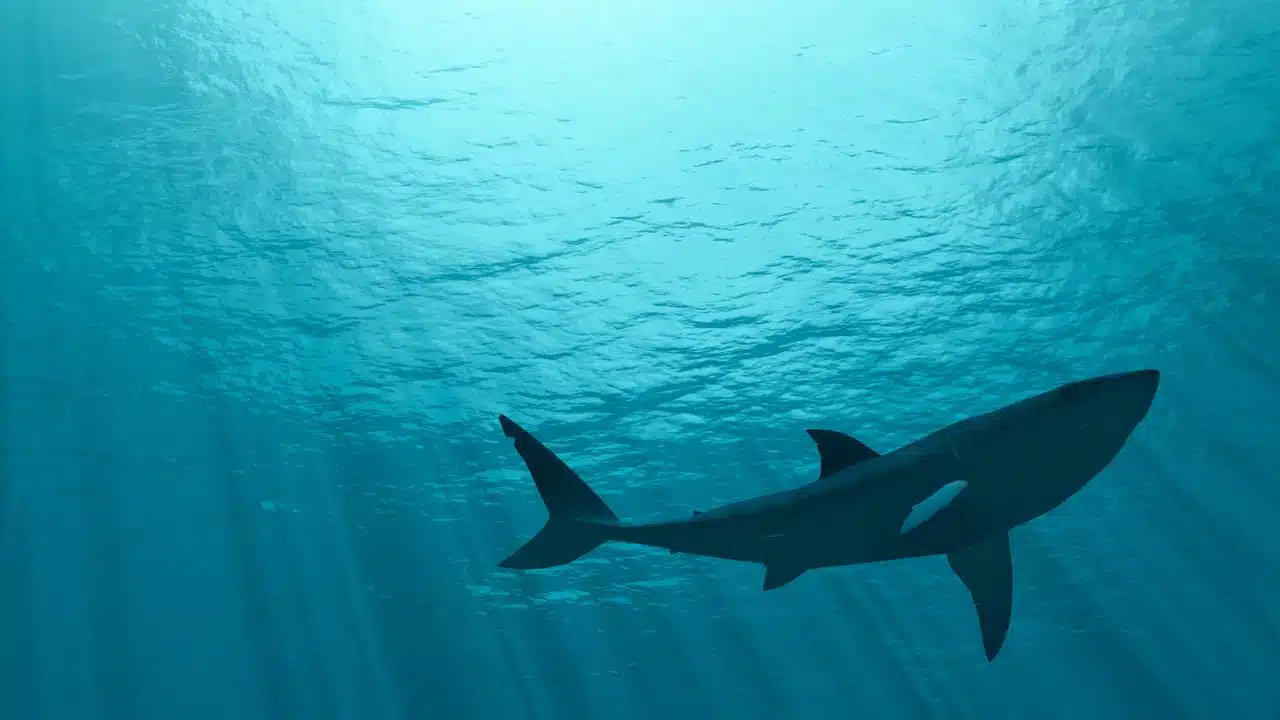The beaches of Cabo San Lucas draw visitors from far and wide, but beyond the sandy shores lies another iridescent feature that makes Cabo shine: the ocean. The waters of Cabo San Lucas look like any other on the surface but dive deep, and you’ll find its standout star. Rare shark species lurk beneath the waves, from the speedy mako to the eye-catching blue sharks. Practically year-round, there’s always something in the water, making shark diving in Cabo a treat. So, if you’re looking for the perfect place for an unforgettable underwater adventure, here’s everything you need to know about shark diving in Cabo.
Table of Contents
- Can You Go Shark Diving in Cabo?
- What Types of Sharks Can You See on a Cabo Shark Diving Trip?
- Cabo Shark Diving: Is It Safe?
- When Is the Best Time of the Year to Go Shark Diving in Cabo San Lucas?
- What Do I Need to Bring When I Go Cabo Shark Diving?
- How Do I Get to Cabo San Lucas? Next Vacay
Can You Go Shark Diving in Cabo?
Shark diving in Cabo is one hundred percent possible and one of the city’s most life-changing experiences. That’s saying a lot considering the incredible things you can do in Cabo, like watching underwater sand falls and riding camels in the desert.
In the crystal clear waters of Los Cabos, you can come face to face with one of nature’s most feared and respected creatures … and before the experience is even over, you’ll likely want to do it all over again.
Tour companies in Cabo San Lucas come equipped with unique excursions and exclusive dive sites for appreciating the incredible marine life that populates the Sea of Cortez and the Pacific Ocean, including sea turtles, whales, manta rays, and other big marine animals.
What Types of Sharks Can You See on a Cabo Shark Diving Trip?
The types of sharks you’ll see on your Cabo shark dive primarily depend on when you go. So, if you’re looking for a specific shark encounter experience on your scuba diving adventure, you’ll want to nail down the timing.
Great White Sharks
Much like you rarely see great whites in the movie Jaws, don’t expect to spot these creatures off the shores of Cabo. If you were traveling to Cabo San Lucas to lay eyes on a great white, you’d have to make another trip 150 miles north to Guadalupe Island instead, where they populate the waters surrounding the volcanic island. But fear not—unlike the movies, these 20-foot water giants are far less fearsome and vengeful in real life.
Great White Peak Season: Between July and November, Guadalupe Island has been one of the places to go scuba diving with great whites. However, as of January 2023, Isla Guadalupe is permanently closed to shark-related tourism.
Bull Sharks
While sharks are far from the ruthless man-eaters seen on TV, some species do have to be handled with care. Along with tiger sharks and great whites, bull sharks rank among the world’s top three most dangerous sharks. Though considered aggressive, this is more to do with their feeding habits than with humans. However, bull sharks are known to hunt in Cabo’s warm, shallow waters and much closer to the shore. So, while humans aren’t exactly on the menu, they can occasionally get caught up in the crosshairs. Still, the odds of an attack are only one in over four million.
Bull Shark Peak Season: If you’re down with those odds, plan your visit to Cabo San Lucas from December to May.
Blue Sharks
Named for the color of their skin, blue sharks are—shockingly enough—the only ones to claim the unique coloring. The rare color makes identifying them all the easier, as their vibrant shades of blue stand out, even among the ocean’s deep hues. Blue sharks are among the fastest in the world, and watching them dart through the water, sunlight gleaming off of cobalt skin, is a sight to behold. Because they’re predominantly migratory creatures, a Cabo shark dive is one of the few reliable opportunities to encounter blue sharks in the wild.
Blue Shark Peak Season: Plan your visit from December to May to experience this unique shark encounter.
Whale Sharks
Swimming with sharks doesn’t get much better than swimming with whale sharks. These gentle giants of the sea are the largest living fish and one of the most peaceful marine creatures humans will ever encounter.
Though they are technically sharks, this feels largely in name only. Looking at its flattened head and wide mouth—perfect for eating plankton, its primary food source—their appearance heavily favors the whale part of their name, as does their docile demeanor. Though whale sharks don’t frequent the waters near Cabo San Lucas, preferring the plankton-rich waters of La Paz, only a two-hour scenic journey separates you from the swim of your life.
What Is the Best Month to Swim with Whale Sharks in Cabo?
You can occasionally spot whale sharks throughout the year in Cabo San Lucas, but the official whale shark season stretches from November to March. However, the best time to swim with whale sharks begins in January. Water temperatures drop during this time, and small invertebrate numbers swell, especially in La Paz. This brings in crowds of whale sharks, with numbers jumping from as low as a few dozen up to hundreds.
A few tour companies in Cabo San Lucas offer a La Paz whale shark tour. So, you can still stay in Cabo and plan a day trip to La Paz to see these stunning creatures up close.
Hammerhead Sharks
Most people are familiar with the hammerhead shark, thanks to its rather unique head shape—hence the rather on-the-nose name. But you won’t find just one type of hammerhead shark in the waters around Cabo San Lucas. Of the nine species of hammerheads, Cabo welcomes two of them: the smooth hammerhead and the scalloped. Smooth hammerheads stick near the water’s surface and are a common sighting in bays, while scalloped hammerheads are much shier and tend to avoid people.
Hammerhead Shark Peak Season: Hammerheads love cooler water temperatures, so you’ll find them lurking around Cabo from April to June.
Mako Sharks
Just as the cheetah rules the plains, the mako shark rules the deep. Mako sharks can swim up to 45 mph, making them the fastest in the sea. If you catch the mako shark as it hunts, you may glimpse even more incredible athletic abilities, like 30-foot leaps in the air.
Mako Shark Peak Season: Thanks to their elusive nature and migratory habits, the best viewings of mako sharks come between December and May.
Silky Sharks
Like the blue shark, the name for the silky shark comes from its smooth, silky-looking skin. Of course, upon inspection, the name holds up to the touch, too, with a texture as smooth as satin. Silky sharks have excellent hearing and streamlined bodies, which allows them to locate their prey before attacking at lightning speed. While they’re not known to attack humans, silky sharks aren’t shy, and if provoked, they’re not shy about making their displeasure known. As such, it’s best to admire them from a safe distance.
Silky Shark Peak Season: Silky sharks are one of the most common sharks you’ll see in the water, but for the best sightings, head to Cabo San Lucas from April to December.
Cabo Shark Diving: Is It Safe?
Diving in Cabo San Lucas is absolutely safe. In fact, it’s one of the safest ways to explore the Sea of Cortez and the Pacific Ocean. Unprovoked shark attacks are rare, accounting for only 57 of 108 recorded attacks in 2022. Furthermore, research shows only a few of those incidents involved divers. Historically, scuba diving is actually much safer than swimming or surfing in the water.
Has Anyone Been Bitten Shark Diving in Cabo?
No one has ever been bitten while shark diving in Cabo. Furthermore, since 1580, the Shark Attack File has only recorded 41 unprovoked shark attacks in Mexico, and just two have occurred in Baja California Sur since 1907.
How Can I Stay Safe While Scuba Diving in Cabo?
Safety is essential, even when doing relatively safe activities like scuba diving or free diving with sharks. Just because no one has ever been bitten shark diving in Cabo doesn’t mean you want to be the first. So, choose a reputable company to keep your shark diving experience in Cabo San Lucas fun and safe. As you’re choosing a tour operator, consider three important questions.
- How safe are the guests when diving?
- How knowledgeable and equipped are the staff to assist guests in having a safe dive?
- How safe are the sharks?
If any of these factors feels off or wrong, it could ruin your experience and turn what should have been unforgettable memories into ones you’d like to forget.
So, carefully research the companies you’re considering. Whether you’re scuba diving, free diving, snorkeling, or just doing a boat tour, go over their safety protocols and read the reviews of previous guests for any red flags. Putting in the work beforehand will guarantee you a fantastic and memorable shark dive once you set off from the shore.
When Is the Best Time of the Year to Go Shark Diving in Cabo San Lucas?
Shark season varies depending on the shark species. But, one timeframe is the undisputed king: October to November. While diving throughout the year is possible, the waters are significantly warmer during this time, with a more tropical temperature and visibility for days. It’s the best time to take in the unbelievable marine wildlife as you shark dive, swim with turtles, or even snorkel with a playful sea lion colony.
What Do I Need to Bring When I Go Cabo Shark Diving?
If you’re going swimming with sharks, you’ll need to make sure you have the proper equipment. Whether you want to experience your shark encounter from a boat or the water will determine what you need to bring.
Some dive and snorkeling tours will provide scuba and snorkeling gear; however, you’ll be on your own for the simple things, like seasickness medication, reef-safe sunscreen, and something warm to put on when you get out of the water, such as a jacket. Though some tours will provide professional underwater photographers to capture your special moments in the water, you may also want to bring a camera for pictures above the surface.
Do I Need My Own Scuba Gear?
Whether you’re gearing up for a free dive or scuba dive, you likely won’t need to bring your own equipment on your Cabo shark dive. Yes, that’s your permission slip for leaving the full snorkeling gear and wetsuits at home. Many companies operating shark encounters in Cabo offer rentals or full equipment with their tour packages. So, by choosing the right company and package, you can plan to pack a little lighter on your trip to paradise.
How Do I Get to Cabo San Lucas? Next Vacay
Before diving deep into Cabo San Lucas’s waters or playing with the myriad marine life in its depths, you’ll need a plane ticket and a passport. While you’re on your own with the latter, Next Vacay can help you score amazing deals to the Los Cabos Airport. Prepare to enjoy the rich culture of San Jose del Cabo and the stunning beaches of Cabo San Lucas.
Whether you’re headed to Mexico or around the world, Next Vacay can help you save hundreds on your next flight and pocket the extra.
Fly the skies. Swim with sharks. Next Vacay will make your travel easy. You’ll make it unforgettable.



